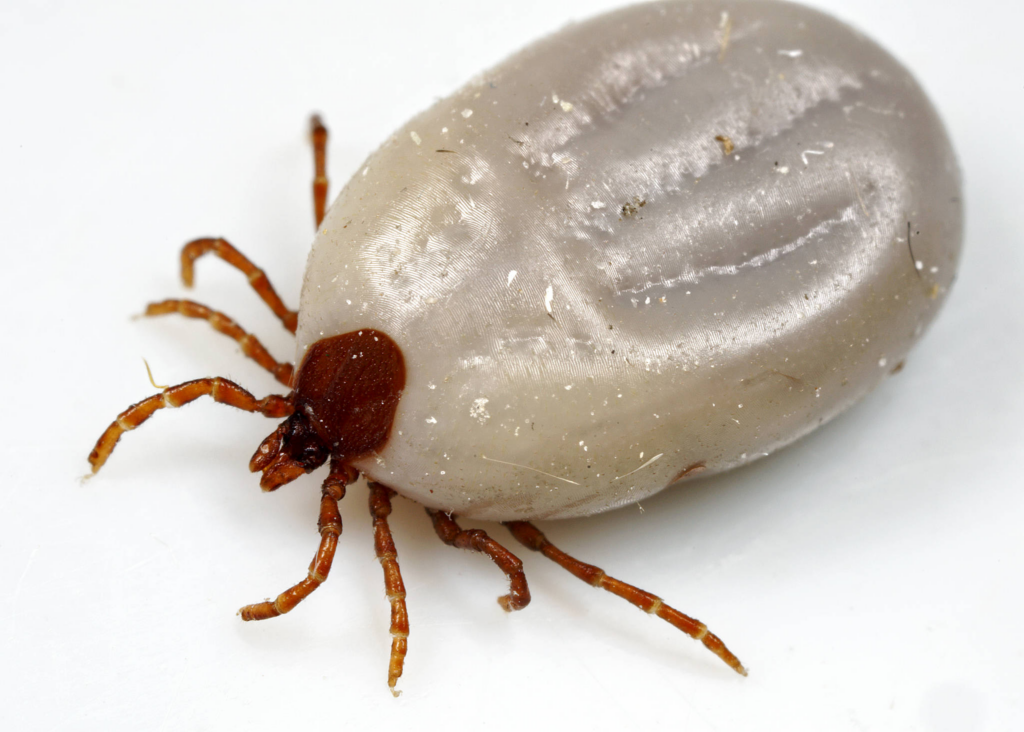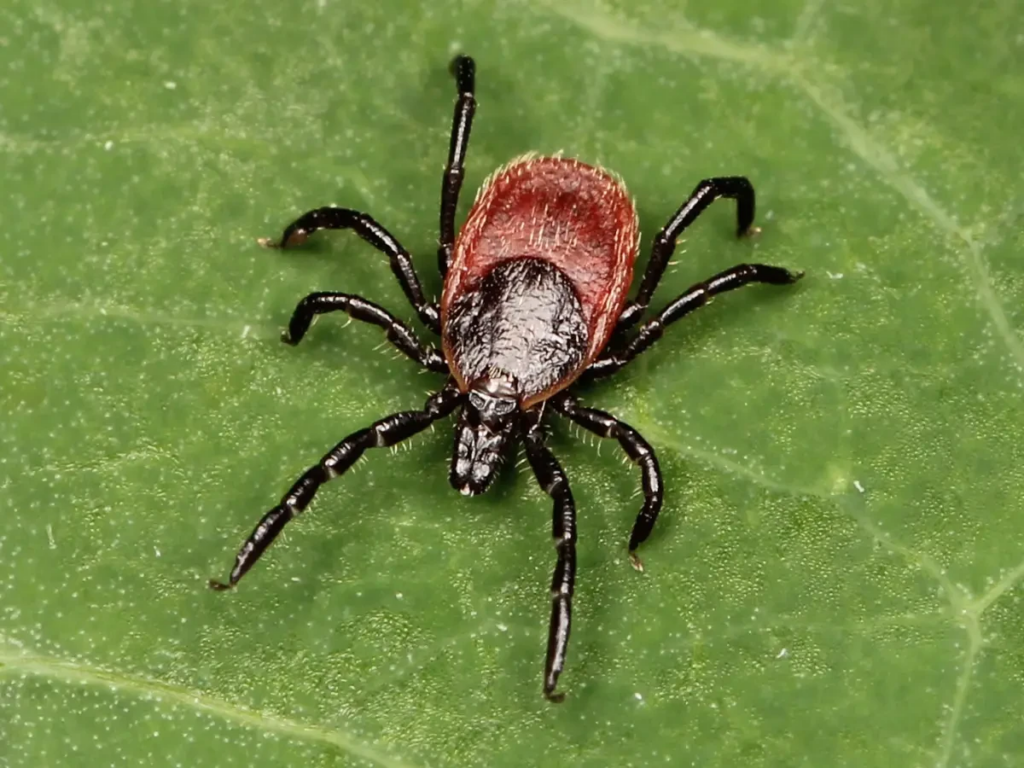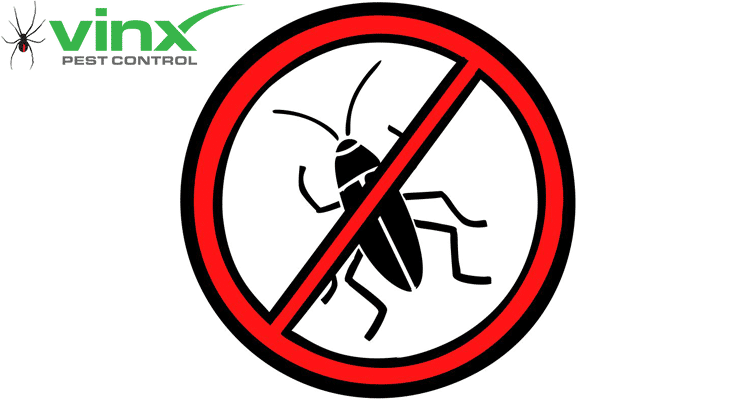Ticks are tiny, wingless, blood-sucking parasites. They cause almost 95% of vector-borne diseases in the United States. Vinx Pest Control says knowing about ticks is key to controlling them. We’ll show you how to remove and prevent ticks.
This guide will teach you many ways to fight ticks. You’ll learn about different tick types and the diseases they spread. By the end, you’ll know how to get rid of ticks with an exterminator and also using DIY methods.
Key Takeaways
- Understanding the tick problem is the first step towards effective tick control.
- Different tick species carry different diseases, making identification critical.
- Effective tick removal techniques can prevent tick-borne diseases.
- Prevention strategies are key to avoiding tick infestations.
- Protecting yourself and your family requires a complete approach to tick control.
The Growing Tick Problem in America
Ticks and tick-borne diseases are becoming more common. It’s important to know why. Tick numbers are going up, and they’re spreading across the US.
Why Tick Populations Are Increasing
Several things are making ticks more common. Climate change is one reason, changing where ticks can live. Changes in how we use land and our activities also bring us closer to ticks.
Geographic Distribution of Ticks in the US
Ticks are now found in more places than before. The black-legged tick, lone star tick, and American dog tick are common. Knowing where they are helps us fight them better.

The Impact on Public Health
More ticks mean more diseases for people. We need good ways to stop ticks. At Vinx Pest Control, we focus on keeping people safe from ticks.
Understanding Different Tick Species
Ticks are not just pests; they carry serious diseases. Knowing about their types is important for staying safe. The United States has many tick species, each with its own look and where it lives.
Deer Ticks (Blacklegged Ticks)
Deer ticks, also known as blacklegged ticks, spread Lyme disease. They are small, about the size of a sesame seed.
Identification Features
Deer ticks have a black shiny body with a reddish-brown spot on their back. The females are longer than the males.
Common Habitats
These ticks live in wooded, bushy, and grassy places. They are most active in spring and fall.
American Dog Ticks
American dog ticks are common in the US. They bite painfully and can spread diseases like Rocky Mountain spotted fever.
Lone Star Ticks
Lone Star ticks have a white spot on the back of females. They are aggressive and can spread diseases like ehrlichiosis and tularemia.
Brown Dog Ticks
Brown dog ticks mostly live on dogs but can also be in homes. They spread diseases like canine ehrlichiosis and babesiosis.
Tick-Borne Diseases and Health Risks
Tick bites can spread many diseases, which are a big risk to people. Ticks carry many harmful germs. Knowing about these diseases helps us fight them better.
Lyme Disease: Symptoms and Treatment
Lyme disease is a common tick-borne illness in the U.S. It causes fever, headache, and a “bull’s-eye” rash. If not treated, it can cause serious problems like arthritis and brain issues. Antibiotics are the best treatment when started early.
Rocky Mountain Spotted Fever
Rocky Mountain Spotted Fever (RMSF) is a serious tick-borne disease. It has symptoms like fever, headache, and rash. If not treated quickly with antibiotics, it can be deadly. It’s key to spot the symptoms early to avoid serious problems.
Anaplasmosis and Ehrlichiosis
Anaplasmosis and Ehrlichiosis affect white blood cells. They cause symptoms like fever, headache, and tiredness. Antibiotics are the treatment, showing how important it is to get a correct diagnosis.
Babesiosis and Other Emerging Diseases
Babesiosis is caused by tick-borne parasites. It can be very serious, mainly for those with weak immune systems. New tick-borne diseases are also being found, making it important to stay alert and keep researching.
When to Seek Medical Attention After a Tick Bite
If you have symptoms like fever, rash, or headache after a tick bite, see a doctor. Quick treatment can greatly help with tick-borne diseases. Watch for these symptoms:
- Fever or chills
- Rash or “bull’s-eye” rash
- Headache or muscle pain
- Joint pain or swelling
Spotting and treating tick-borne diseases early is key to avoiding long-term health problems.

Identifying Tick Habitats and High-Risk Areas
Knowing where ticks live is key to avoiding bites and diseases. Ticks don’t live everywhere. They prefer certain places.
Typical Outdoor Environments for Ticks
Ticks love shady, moist spots with lots of grass and leaves. Wooded areas, grasslands, and even backyard gardens with thick plants are their homes. These places give them shelter, food, and the right humidity.
Seasonal Tick Activity Patterns
Tick activity changes with the seasons. For example, blacklegged ticks are busier in spring and fall. Lone star ticks are active in summer. Knowing this helps plan outdoor fun and stay safe.
Recognizing Tick Hot Spots on Your Property
To find tick spots, look for dense plants, leaf piles, and damp areas. Places near woods, stone walls, and old logs are often tick homes. Keeping leaf piles clean and mowing grass short can help fight ticks.
Wildlife Hosts That Carry Ticks
Deer, rodents, and birds can carry ticks. Managing these animals and using methods to keep them away can help. Knowing how wildlife spreads ticks is important for controlling them.
How to Get Rid of Ticks in Your Yard
To control ticks in your yard, mix landscape changes, tick-repelling plants, and wildlife management. These steps can lower tick numbers in your outdoor areas.
Landscape Modification Techniques
Changing your yard’s layout is key to fighting ticks. It makes your yard less welcoming to ticks.
Creating Tick Barriers
Building tick barriers is a smart move. Use gravel or wood chips to keep ticks out. A 3-foot wide barrier works well.
Proper Mowing and Vegetation Management
Keep your grass short and remove leaves. This makes your yard less tick-friendly. Also, trim trees and shrubs to reduce shade and moisture.
Tick-Repelling Plants and Natural Solutions
Some plants, like lavender and rosemary, keep ticks away. Adding these plants to your yard is a natural way to fight ticks.
Wildlife Management to Reduce Tick Hosts
Ticks need hosts like deer and rodents. Managing these animals can lower tick numbers. Use deer repellents and seal holes to keep rodents out.
Targeted Yard Treatments and Application Methods
For big tick problems, yard treatments are needed. Use acaricides to kill ticks. Always follow the instructions and consider a pro if it’s a big job.
Using these methods can make your yard safer from ticks. Vinx Pest Control offers help with tick control, including yard changes and treatments.
Personal Protection Strategies Against Ticks
Tick populations are growing fast. It’s vital to protect yourself when in tick-prone areas. The right steps can lower the chance of tick bites and diseases.
Proper Clothing and Gear for Tick Prevention
Choosing the right clothes is key to avoiding ticks. Wear long-sleeved shirts, long pants, and closed shoes. Tucking pants into socks stops ticks from climbing up.
- Wear light-colored clothes to spot ticks easily.
- Use permethrin-treated clothes for extra protection.
- Look for clothes with built-in tick defense.
Effective Commercial Tick Repellents
Using tick repellents is also important. There are many types, each with its own benefits.
DEET-Based Products
DEET-based repellents are very effective. The higher the DEET concentration, the longer it lasts.
Permethrin Treatments for Clothing
Permethrin is a strong tick repellent for clothes and gear. It stays effective through many washes, great for outdoor lovers.
Comprehensive Body Check Procedures
Do a detailed body check after being outside. This is to find and remove ticks before they can harm you.
- Check yourself, kids, and pets well.
- Focus on areas like armpits, groin, and scalp.
- Use a mirror or ask someone to help with hard spots.
Creating Personal Tick Protection Habits
Being consistent in tick prevention is essential. Making protection habits can greatly lower your risk of tick encounters.

Natural and DIY Tick Repellent Solutions
Natural and DIY tick repellents are good alternatives to harsh chemicals. They are worth exploring, but knowing their strengths and weaknesses is key.
Essential Oils Proven to Repel Ticks
Essential oils like lemongrass, peppermint, and geranium can keep ticks away. You can use them alone or mix them for better results.
Homemade Tick Repellent Recipes
Homemade recipes mix essential oils with coconut oil or apple cider vinegar. These blends can be applied to skin or clothes to keep ticks off.
Natural Yard Treatments and Their Effectiveness
Using plants like lavender or rosemary in your yard can repel ticks. You can also apply natural substances. But, how well they work depends on your yard’s size and tick population.
Limitations of Natural Solutions
Natural and DIY solutions are good, but they might not protect as well as commercial products. It’s important to know their limits. You might need to use them along with other tick control methods.
Safe and Effective Tick Removal Techniques
Preventing tick-borne illnesses starts with safe tick removal. Ticks carry serious diseases. Removing them right is key to avoid infection.
Recommended Tick Removal Tools
For safe tick removal, we need the right tools. Fine-tipped tweezers are best. They let you grab the tick close to your skin.
Step-by-Step Tick Removal Process
Removing a tick is simple. Follow the steps right to lower disease risk.
Proper Technique for Attached Ticks
To remove a tick, use tweezers close to your skin. Pull up slowly and steadily. Don’t twist or jerk it.
Aftercare for the Bite Area
After removing the tick, wash the area with soap and water. Apply an antiseptic. Also, note the date and location of the bite.
Common Removal Mistakes to Avoid
Some mistakes can raise infection risk. Avoid using petroleum jelly or heat. These can make the tick release more pathogens.
- Using home remedies like petroleum jelly or heat
- Twisting or jerking the tick during removal
- Not cleaning the bite area after removal
Preserving Ticks for Identification or Testing
To identify or test a tick, preserve it well. Put it in a sealed bag or container and freeze it. For more info, check tick submission guidelines.
Protecting Your Pets from Tick Infestations
Ticks are a big threat to our pets. It’s important to know how to keep them safe. As ticks spread, the risk of diseases in pets grows. So, pet owners must act fast.
Veterinary-Approved Tick Prevention Products
Using tick prevention products approved by vets is key. These include topical treatments, oral meds, and tick collars. Always talk to a vet to find the best one for your pet. Consider your pet’s age, health, and where you live.
Regular Pet Checking Routines
Checking your pets for ticks is a must, more so after they’ve been outside. We suggest checking them every day. Look closely at their ears, neck, and paws. Finding ticks early can help prevent diseases.

Creating Tick-Safe Pet Areas
Make areas around your home tick-free. Keep your yard clean, remove leaf litter, and cut grass short. Also, use tick control products in your yard to fight ticks.
What to Do If You Find a Tick on Your Pet
If you find a tick on your pet, remove it right away. Use tweezers to grab the tick close to your pet’s skin. Pull it up slowly and steadily. Then, clean the bite with antiseptic and see your vet.
Indoor Tick Control Methods
Ticks can be found indoors, making it important to control them inside. We need to stop ticks from getting in, treat areas they infest, manage pets, and check regularly.
Preventing Ticks from Entering Your Home
To keep ticks out, seal cracks around windows and doors. Remove leaf litter and debris from your home’s edges. Also, check pets and people for ticks before they come inside.
Treating Furniture, Carpets, and Bedding
Wash and dry items on high heat to treat them. Use diatomaceous earth or other safe powders on carpets. Apply tick treatments to furniture and upholstered items.
Managing Ticks on Indoor-Outdoor Pets
Check pets regularly for ticks. Use tick prevention products approved by vets. Make areas in your home safe from ticks.
Regular Inspection and Maintenance Routines
Regular checks and upkeep are vital for indoor tick control. Look for ticks in your home often. Keep your space clean and clutter-free. Make sure your yard is tick-free.
Professional Tick Control Services by Vinx Pest Control
Vinx Pest Control offers top-notch tick control services. We help you take back your outdoor space. Our team knows how serious tick infestations and diseases are.
Comprehensive Property Assessment
We start with a detailed property check. This helps us find where ticks live and where they’re most likely to be. It’s key to making a tick control plan just for you.
Advanced Treatment Technologies and Methods
We use the latest in tick control tech and methods. Our treatments are safe for your family, pets, and the planet. They target ticks well.
Integrated Tick Management Programs
Our tick management plans use many strategies for lasting results. We modify landscapes, manage wildlife, and use specific treatments. This makes your space tick-free.
Long-Term Prevention Strategies
We also focus on preventing ticks from coming back. We do regular checks, upkeep, and teach you how to prevent ticks.
Why Professional Tick Control Is Often Necessary
Getting professional help is often needed because tick problems are complex. Our team’s skills ensure tick control. This lowers the risk of disease.

Conclusion: Creating a Sustainable Tick-Free Environment
To make our yards tick-free, we need to use many methods. We can change our landscapes and use plants that keep ticks away. We also need to use natural predators to fight ticks.
Keeping our yards clean is key. This means mowing the lawn and removing leaves. For more tips on fighting ticks naturally, check out The Yard Gard.
We can also protect ourselves by wearing the right clothes and using tick repellents. If ticks are a big problem, getting help from professionals is a good idea. This way, we can keep our families, pets, and the environment safe from tick-borne diseases.
By using green ways to fight ticks, we can make our outdoor spaces safer. Our aim is to have yards that are healthy and fun for everyone.
FAQ
Q: What are the most effective methods for getting rid of ticks in my yard?
A: To get rid of ticks, try a few things. Change your yard to make it less welcoming to ticks. Use plants that keep ticks away. Also, manage wildlife that ticks like to hide in. And, use special treatments for your yard.
Q: How can I identify tick habitats and high-risk areas on my property?
A: Look for ticks in wooded, bushy, or grassy spots. Know when ticks are most active. Also, watch for wildlife that ticks like to hide in.
Q: What are the best tick removal tools, and how do I use them?
A: Use tweezers or special tick removal tools. Hold the tick close to your skin and pull up slowly and steadily.
Q: How can I protect my pets from tick infestations?
A: Use tick prevention products for pets. Check them often for ticks. Make safe areas for pets. If you find a tick, remove it right away.
Q: What are some natural and DIY tick repellent solutions I can try?
A: Try essential oils like lemongrass and peppermint. You can also make your own repellents. But, know they might not work for everyone.
Q: When should I seek medical attention after a tick bite?
A: See a doctor if you have fever, headache, or rash after a tick bite. Or if you’re not sure about the tick or the bite.
Q: How can I prevent ticks from entering my home?
A: Seal entry points and clean up clutter. Treat furniture and bedding to kill ticks.
Q: What are the benefits of professional tick control services?
A: Professional services like Vinx Pest Control do detailed checks and use advanced treatments. They offer long-term solutions to keep ticks away.
Q: How can I create a sustainable tick-free environment?
A: Mix yard treatments and personal protection with regular checks. Keep up with prevention to keep your yard tick-free.
Q: What are some common tick-borne diseases, and how can I prevent them?
A: Diseases like Lyme disease and Rocky Mountain spotted fever come from ticks. Avoid ticks, use repellents, and remove ticks quickly to prevent these diseases.



